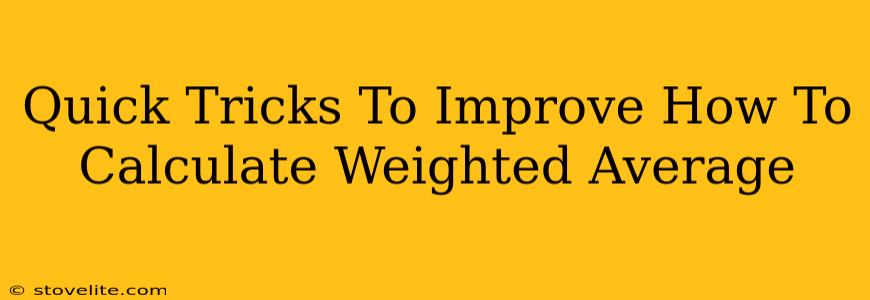Calculating a weighted average might seem daunting at first, but with a few quick tricks, you'll be a pro in no time! This guide breaks down the process, offering simple explanations and helpful tips to improve your understanding and speed. We'll cover everything from the basic formula to advanced scenarios, ensuring you can confidently tackle any weighted average problem.
Understanding the Weighted Average Formula
The core of any weighted average calculation lies in understanding its formula. At its simplest, it's about giving different values different levels of importance. Instead of simply averaging numbers, we're acknowledging that some numbers matter more than others.
The basic formula is:
Weighted Average = Σ (Weight * Value) / Σ Weight
Let's break that down:
- Σ (Weight * Value): This means "the sum of (each weight multiplied by its corresponding value)." You multiply each value by its weight and then add up all those products.
- Σ Weight: This is simply "the sum of all the weights." You add up all the individual weights assigned to each value.
Quick Trick #1: Organize Your Data
Before you even start crunching numbers, organize your data into a clear table. This simple step dramatically reduces errors and makes the calculation much easier to follow. Use columns for "Value," "Weight," "Weight * Value," and then a final row for sums. This visual representation helps with accuracy and makes the process more intuitive.
Quick Trick #2: Use a Spreadsheet
Spreadsheets (like Google Sheets or Excel) are your best friends when dealing with weighted averages, especially with larger datasets. They automatically handle the calculations, reducing the risk of manual errors and saving you a significant amount of time. Simply input your values and weights, and let the spreadsheet do the heavy lifting! Use formulas like SUMPRODUCT and SUM to streamline the calculation based on the formula above.
Quick Trick #3: Check Your Work!
Always double-check your calculations. A simple mistake in one multiplication can throw off the entire weighted average. Use a calculator to verify individual multiplications, and make sure your final sum is reasonable in the context of your data.
Advanced Scenarios and Applications
While the basic formula covers most situations, some scenarios require a slightly different approach. Here are a couple of examples:
Weighted Average with Percentages
Often, weights are expressed as percentages. Just remember to convert percentages to decimals before applying the formula (e.g., 25% becomes 0.25). The process remains the same; you just need an extra step of conversion.
Weighted Average in Finance
Weighted averages are commonly used in finance to calculate things like portfolio returns (where each investment holds a different weight based on its size) or the weighted average cost of capital (WACC). Understanding weighted averages is key to many financial calculations.
Conclusion
Mastering weighted average calculations isn't about complex formulas; it's about organization, accuracy, and leveraging the right tools. By employing these quick tricks and understanding the underlying principles, you can confidently calculate weighted averages in any context and improve your efficiency. Remember to organize your data, use a spreadsheet for larger calculations, and always double-check your work. With practice, you'll find calculating weighted averages becomes second nature!

